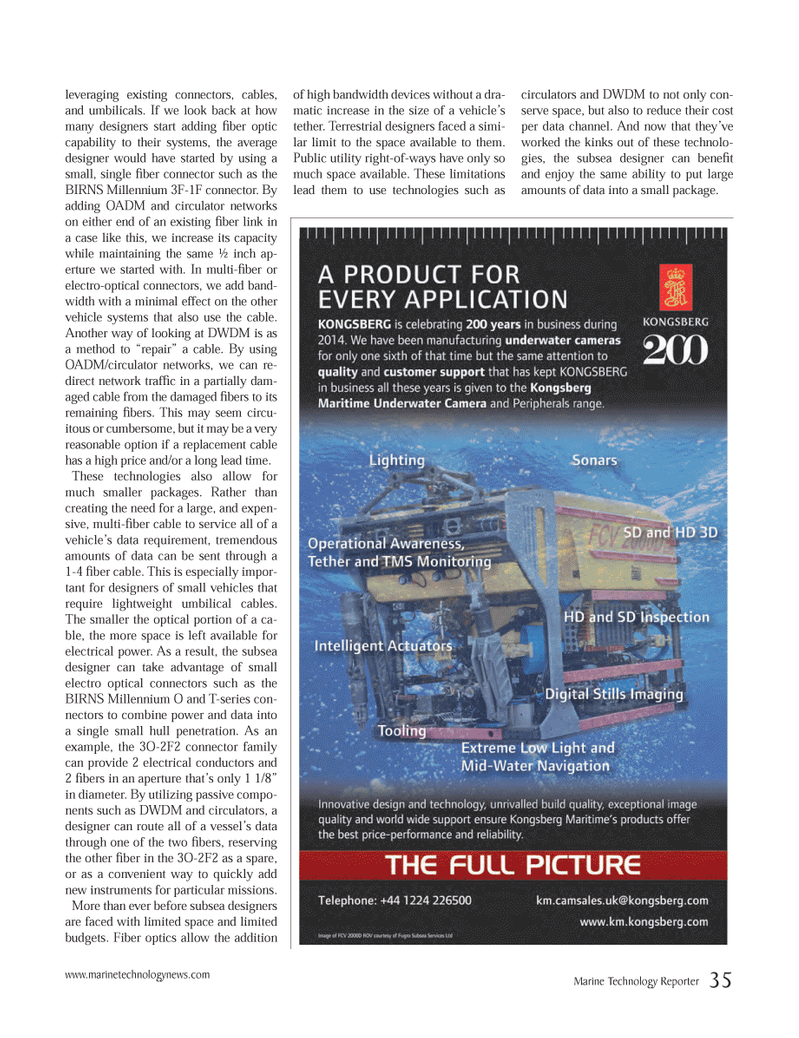
Page 35: of Marine Technology Magazine (September 2014)
Ocean Observation: Gliders, Buoys & Sub-Surface Networks
Read this page in Pdf, Flash or Html5 edition of September 2014 Marine Technology Magazine
leveraging existing connectors, cables, and umbilicals. If we look back at how many designers start adding fi ber optic capability to their systems, the average designer would have started by using a small, single fi ber connector such as the
BIRNS Millennium 3F-1F connector. By adding OADM and circulator networks on either end of an existing fi ber link in a case like this, we increase its capacity while maintaining the same ½ inch ap- erture we started with. In multi-fi ber or electro-optical connectors, we add band- width with a minimal effect on the other vehicle systems that also use the cable.
Another way of looking at DWDM is as a method to “repair” a cable. By using
OADM/circulator networks, we can re- direct network traffi c in a partially dam- aged cable from the damaged fi bers to its remaining fi bers. This may seem circu- itous or cumbersome, but it may be a very reasonable option if a replacement cable has a high price and/or a long lead time.
These technologies also allow for much smaller packages. Rather than creating the need for a large, and expen- sive, multi-fi ber cable to service all of a vehicle’s data requirement, tremendous amounts of data can be sent through a 1-4 fi ber cable. This is especially impor- tant for designers of small vehicles that require lightweight umbilical cables.
The smaller the optical portion of a ca- ble, the more space is left available for electrical power. As a result, the subsea designer can take advantage of small electro optical connectors such as the
BIRNS Millennium O and T-series con- nectors to combine power and data into a single small hull penetration. As an example, the 3O-2F2 connector family can provide 2 electrical conductors and 2 fi bers in an aperture that’s only 1 1/8” in diameter. By utilizing passive compo- nents such as DWDM and circulators, a designer can route all of a vessel’s data through one of the two fi bers, reserving the other fi ber in the 3O-2F2 as a spare, or as a convenient way to quickly add new instruments for particular missions.
More than ever before subsea designers are faced with limited space and limited budgets. Fiber optics allow the addition of high bandwidth devices without a dra- matic increase in the size of a vehicle’s tether. Terrestrial designers faced a simi- lar limit to the space available to them.
Public utility right-of-ways have only so much space available. These limitations lead them to use technologies such as circulators and DWDM to not only con- serve space, but also to reduce their cost per data channel. And now that they’ve worked the kinks out of these technolo- gies, the subsea designer can benefi t and enjoy the same ability to put large amounts of data into a small package. www.marinetechnologynews.com
Marine Technology Reporter 35
MTR #7 (34-49).indd 35 8/27/2014 9:31:34 AM

 34
34

 36
36
